+ Open data
Open data
- Basic information
Basic information
| Entry | Database: EMDB / ID: EMD-25091 | |||||||||
|---|---|---|---|---|---|---|---|---|---|---|
| Title | ChRmine in MSP1E3D1 lipid nanodisc | |||||||||
 Map data Map data | ChRmine in MSP1E3D1 lipid nanodisc | |||||||||
 Sample Sample |
| |||||||||
| Biological species |  Tiarina fusa (eukaryote) / Tiarina fusa (eukaryote) /  Rhodomonas lens (eukaryote) Rhodomonas lens (eukaryote) | |||||||||
| Method | single particle reconstruction / cryo EM / Resolution: 2.74 Å | |||||||||
 Authors Authors | Tucker K / Brohawn S | |||||||||
| Funding support |  United States, 1 items United States, 1 items
| |||||||||
 Citation Citation |  Journal: Nat Commun / Year: 2022 Journal: Nat Commun / Year: 2022Title: Cryo-EM structures of the channelrhodopsin ChRmine in lipid nanodiscs. Authors: Kyle Tucker / Savitha Sridharan / Hillel Adesnik / Stephen G Brohawn /  Abstract: Microbial channelrhodopsins are light-gated ion channels widely used for optogenetic manipulation of neuronal activity. ChRmine is a bacteriorhodopsin-like cation channelrhodopsin (BCCR) more closely ...Microbial channelrhodopsins are light-gated ion channels widely used for optogenetic manipulation of neuronal activity. ChRmine is a bacteriorhodopsin-like cation channelrhodopsin (BCCR) more closely related to ion pump rhodopsins than other channelrhodopsins. ChRmine displays unique properties favorable for optogenetics including high light sensitivity, a broad, red-shifted activation spectrum, cation selectivity, and large photocurrents, while its slow closing kinetics impedes some applications. The structural basis for ChRmine function, or that of any other BCCR, is unknown. Here, we present cryo-EM structures of ChRmine in lipid nanodiscs in apo (opsin) and retinal-bound (rhodopsin) forms. The structures reveal an unprecedented trimeric architecture with a lipid filled central pore. Large electronegative cavities on either side of the membrane facilitate high conductance and selectivity for cations over protons. The retinal binding pocket structure suggests channel properties could be tuned with mutations and we identify ChRmine variants with ten-fold decreased and two-fold increased closing rates. A T119A mutant shows favorable properties relative to wild-type and previously reported ChRmine variants for optogenetics. These results provide insight into structural features that generate an ultra-potent microbial opsin and provide a platform for rational engineering of channelrhodopsins with improved properties that could expand the scale, depth, and precision of optogenetic experiments. | |||||||||
| History |
|
- Structure visualization
Structure visualization
| Movie |
 Movie viewer Movie viewer |
|---|---|
| Structure viewer | EM map:  SurfView SurfView Molmil Molmil Jmol/JSmol Jmol/JSmol |
| Supplemental images |
- Downloads & links
Downloads & links
-EMDB archive
| Map data |  emd_25091.map.gz emd_25091.map.gz | 38.3 MB |  EMDB map data format EMDB map data format | |
|---|---|---|---|---|
| Header (meta data) |  emd-25091-v30.xml emd-25091-v30.xml emd-25091.xml emd-25091.xml | 12.2 KB 12.2 KB | Display Display |  EMDB header EMDB header |
| Images |  emd_25091.png emd_25091.png | 189.3 KB | ||
| Archive directory |  http://ftp.pdbj.org/pub/emdb/structures/EMD-25091 http://ftp.pdbj.org/pub/emdb/structures/EMD-25091 ftp://ftp.pdbj.org/pub/emdb/structures/EMD-25091 ftp://ftp.pdbj.org/pub/emdb/structures/EMD-25091 | HTTPS FTP |
-Validation report
| Summary document |  emd_25091_validation.pdf.gz emd_25091_validation.pdf.gz | 447 KB | Display |  EMDB validaton report EMDB validaton report |
|---|---|---|---|---|
| Full document |  emd_25091_full_validation.pdf.gz emd_25091_full_validation.pdf.gz | 446.6 KB | Display | |
| Data in XML |  emd_25091_validation.xml.gz emd_25091_validation.xml.gz | 6 KB | Display | |
| Data in CIF |  emd_25091_validation.cif.gz emd_25091_validation.cif.gz | 6.9 KB | Display | |
| Arichive directory |  https://ftp.pdbj.org/pub/emdb/validation_reports/EMD-25091 https://ftp.pdbj.org/pub/emdb/validation_reports/EMD-25091 ftp://ftp.pdbj.org/pub/emdb/validation_reports/EMD-25091 ftp://ftp.pdbj.org/pub/emdb/validation_reports/EMD-25091 | HTTPS FTP |
-Related structure data
| Related structure data |  7sfkMC  7sfjC  7shsC M: atomic model generated by this map C: citing same article ( |
|---|---|
| Similar structure data |
- Links
Links
| EMDB pages |  EMDB (EBI/PDBe) / EMDB (EBI/PDBe) /  EMDataResource EMDataResource |
|---|
- Map
Map
| File |  Download / File: emd_25091.map.gz / Format: CCP4 / Size: 40.6 MB / Type: IMAGE STORED AS FLOATING POINT NUMBER (4 BYTES) Download / File: emd_25091.map.gz / Format: CCP4 / Size: 40.6 MB / Type: IMAGE STORED AS FLOATING POINT NUMBER (4 BYTES) | ||||||||||||||||||||||||||||||||||||||||||||||||||||||||||||||||||||
|---|---|---|---|---|---|---|---|---|---|---|---|---|---|---|---|---|---|---|---|---|---|---|---|---|---|---|---|---|---|---|---|---|---|---|---|---|---|---|---|---|---|---|---|---|---|---|---|---|---|---|---|---|---|---|---|---|---|---|---|---|---|---|---|---|---|---|---|---|---|
| Annotation | ChRmine in MSP1E3D1 lipid nanodisc | ||||||||||||||||||||||||||||||||||||||||||||||||||||||||||||||||||||
| Projections & slices | Image control
Images are generated by Spider. | ||||||||||||||||||||||||||||||||||||||||||||||||||||||||||||||||||||
| Voxel size | X=Y=Z: 1.137 Å | ||||||||||||||||||||||||||||||||||||||||||||||||||||||||||||||||||||
| Density |
| ||||||||||||||||||||||||||||||||||||||||||||||||||||||||||||||||||||
| Symmetry | Space group: 1 | ||||||||||||||||||||||||||||||||||||||||||||||||||||||||||||||||||||
| Details | EMDB XML:
CCP4 map header:
| ||||||||||||||||||||||||||||||||||||||||||||||||||||||||||||||||||||
-Supplemental data
- Sample components
Sample components
-Entire : ChRmine trimer
| Entire | Name: ChRmine trimer |
|---|---|
| Components |
|
-Supramolecule #1: ChRmine trimer
| Supramolecule | Name: ChRmine trimer / type: complex / ID: 1 / Parent: 0 / Macromolecule list: #1 |
|---|---|
| Source (natural) | Organism:  Tiarina fusa (eukaryote) Tiarina fusa (eukaryote) |
| Recombinant expression | Organism:  |
| Molecular weight | Theoretical: 110 KDa |
-Macromolecule #1: ChRmine
| Macromolecule | Name: ChRmine / type: protein_or_peptide / ID: 1 / Number of copies: 3 / Enantiomer: LEVO |
|---|---|
| Source (natural) | Organism:  Rhodomonas lens (eukaryote) Rhodomonas lens (eukaryote) |
| Molecular weight | Theoretical: 36.602957 KDa |
| Recombinant expression | Organism:  |
| Sequence | String: M(AYA)HAPGTDQM FYVGTMDGWY LDTKLNSVAI GAHWSCFIVL TITTFYLGYE SWTSRGPSKR TSFYAGYQEE QNLALF VNF FAMLSYFGKI VADTLGHNFG DVGPFIIGFG NYRYADYMLT CPMLVYDLLY QLRAPYRVSC SAIIFAILMS GVLAEFY AE GDPRLRNGAY ...String: M(AYA)HAPGTDQM FYVGTMDGWY LDTKLNSVAI GAHWSCFIVL TITTFYLGYE SWTSRGPSKR TSFYAGYQEE QNLALF VNF FAMLSYFGKI VADTLGHNFG DVGPFIIGFG NYRYADYMLT CPMLVYDLLY QLRAPYRVSC SAIIFAILMS GVLAEFY AE GDPRLRNGAY AWYGFGCFWF IFAYSIVMSI VAKQYSRLAQ LAQDTGAEHS LHVLKFAVFT FSMLWILFPL VWAICPRG F GWIDDNWTEV AHCVCDIVAK SCYGFALARF RKTYDEELFR LLEQLGHDED EFQKLELDMR LSSNGERLRR LSLNSLEVL FQ |
-Macromolecule #2: 1,2-dioleoyl-sn-glycero-3-phosphoethanolamine
| Macromolecule | Name: 1,2-dioleoyl-sn-glycero-3-phosphoethanolamine / type: ligand / ID: 2 / Number of copies: 21 / Formula: PEE |
|---|---|
| Molecular weight | Theoretical: 744.034 Da |
| Chemical component information | 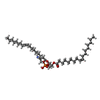 ChemComp-PEE: |
-Macromolecule #3: RETINAL
| Macromolecule | Name: RETINAL / type: ligand / ID: 3 / Number of copies: 3 / Formula: RET |
|---|---|
| Molecular weight | Theoretical: 284.436 Da |
| Chemical component information | 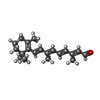 ChemComp-RET: |
-Macromolecule #4: water
| Macromolecule | Name: water / type: ligand / ID: 4 / Number of copies: 57 / Formula: HOH |
|---|---|
| Molecular weight | Theoretical: 18.015 Da |
| Chemical component information |  ChemComp-HOH: |
-Experimental details
-Structure determination
| Method | cryo EM |
|---|---|
 Processing Processing | single particle reconstruction |
| Aggregation state | particle |
- Sample preparation
Sample preparation
| Concentration | 14.4 mg/mL | |||||||||
|---|---|---|---|---|---|---|---|---|---|---|
| Buffer | pH: 7.5 Component:
| |||||||||
| Grid | Model: Quantifoil R1.2/1.3 / Material: GOLD / Mesh: 300 / Support film - Material: CARBON / Support film - topology: HOLEY / Pretreatment - Type: GLOW DISCHARGE | |||||||||
| Vitrification | Cryogen name: ETHANE / Chamber humidity: 100 % / Chamber temperature: 277 K / Instrument: FEI VITROBOT MARK IV |
- Electron microscopy
Electron microscopy
| Microscope | TFS TALOS |
|---|---|
| Image recording | Film or detector model: GATAN K3 (6k x 4k) / Average electron dose: 50.0 e/Å2 |
| Electron beam | Acceleration voltage: 200 kV / Electron source:  FIELD EMISSION GUN FIELD EMISSION GUN |
| Electron optics | Illumination mode: FLOOD BEAM / Imaging mode: BRIGHT FIELD |
 Movie
Movie Controller
Controller






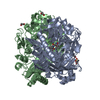
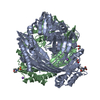

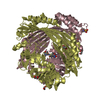
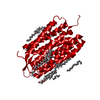
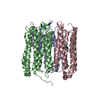

 Z (Sec.)
Z (Sec.) Y (Row.)
Y (Row.) X (Col.)
X (Col.)





















